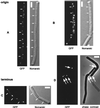Bacillus subtilis SMC is required for proper arrangement of the chromosome and for efficient segregation of replication termini but not for bipolar movement of newly duplicated origin regions
- PMID: 11053392
- PMCID: PMC94794
- DOI: 10.1128/JB.182.22.6463-6471.2000
Bacillus subtilis SMC is required for proper arrangement of the chromosome and for efficient segregation of replication termini but not for bipolar movement of newly duplicated origin regions
Abstract
SMC protein is required for chromosome condensation and for the faithful segregation of daughter chromosomes in Bacillus subtilis. The visualization of specific sites on the chromosome showed that newly duplicated origin regions in growing cells of an smc mutant were able to segregate from each other but that the location of origin regions was frequently aberrant. In contrast, the segregation of replication termini was impaired in smc mutant cells. This analysis was extended to germinating spores of an smc mutant. The results showed that during germination, newly duplicated origins, but not termini, were able to separate from each other in the absence of SMC. Also, DAPI (4',6'-diamidino-2-phenylindole) staining revealed that chromosomes in germinating spores were able to undergo partial or complete replication but that the daughter chromosomes were blocked at a late stage in the segregation process. These findings were confirmed by time-lapse microscopy, which showed that after duplication in growing cells the origin regions underwent rapid movement toward opposite poles of the cell in the absence of SMC. This indicates that SMC is not a required component of the mitotic motor that initially drives origins apart after their duplication. It is also concluded that SMC is needed to maintain the proper layout of the chromosome in the cell and that it functions in the cell cycle after origin separation but prior to complete segregation or replication of daughter chromosomes. It is proposed here that chromosome segregation takes place in at least two steps: an SMC-independent step in which origins move apart and a subsequent SMC-dependent step in which newly duplicated chromosomes condense and are thereby drawn apart.
Figures






Similar articles
-
The chromosome partitioning proteins Soj (ParA) and Spo0J (ParB) contribute to accurate chromosome partitioning, separation of replicated sister origins, and regulation of replication initiation in Bacillus subtilis.Mol Microbiol. 2006 May;60(4):853-69. doi: 10.1111/j.1365-2958.2006.05140.x. Mol Microbiol. 2006. PMID: 16677298
-
The Caulobacter crescentus smc gene is required for cell cycle progression and chromosome segregation.Proc Natl Acad Sci U S A. 1999 Sep 14;96(19):10661-6. doi: 10.1073/pnas.96.19.10661. Proc Natl Acad Sci U S A. 1999. PMID: 10485882 Free PMC article.
-
Subcellular localization of Bacillus subtilis SMC, a protein involved in chromosome condensation and segregation.J Bacteriol. 1998 Nov;180(21):5749-55. doi: 10.1128/JB.180.21.5749-5755.1998. J Bacteriol. 1998. PMID: 9791128 Free PMC article.
-
SMC proteins in bacteria: condensation motors for chromosome segregation?Biochimie. 2001 Jan;83(1):53-9. doi: 10.1016/s0300-9084(00)01218-9. Biochimie. 2001. PMID: 11254975 Review.
-
Upheaval in the bacterial nucleoid. An active chromosome segregation mechanism.Trends Genet. 1999 Feb;15(2):70-4. doi: 10.1016/s0168-9525(98)01660-6. Trends Genet. 1999. PMID: 10098410 Review.
Cited by
-
Coupling of asymmetric division to polar placement of replication origin regions in Bacillus subtilis.J Bacteriol. 2001 Jul;183(13):4052-60. doi: 10.1128/JB.183.13.4052-4060.2001. J Bacteriol. 2001. PMID: 11395470 Free PMC article.
-
The complete genome of the crenarchaeon Sulfolobus solfataricus P2.Proc Natl Acad Sci U S A. 2001 Jul 3;98(14):7835-40. doi: 10.1073/pnas.141222098. Epub 2001 Jun 26. Proc Natl Acad Sci U S A. 2001. PMID: 11427726 Free PMC article.
-
SMC protein-dependent chromosome condensation during aerial hyphal development in Streptomyces.J Bacteriol. 2009 Jan;191(1):310-9. doi: 10.1128/JB.00513-08. Epub 2008 Oct 17. J Bacteriol. 2009. PMID: 18931116 Free PMC article.
-
Orderly Replication and Segregation of the Four Replicons of Burkholderia cenocepacia J2315.PLoS Genet. 2016 Jul 18;12(7):e1006172. doi: 10.1371/journal.pgen.1006172. eCollection 2016 Jul. PLoS Genet. 2016. PMID: 27428258 Free PMC article.
-
Distinct heterochromatin-like domains promote transcriptional memory and silence parasitic genetic elements in bacteria.EMBO J. 2022 Feb 1;41(3):e108708. doi: 10.15252/embj.2021108708. Epub 2021 Dec 28. EMBO J. 2022. PMID: 34961960 Free PMC article.
References
-
- Akhmedov A T, Frei C, Tsai-Pflugfelder M, Kemper B, Gasser S M, Jessberger R. Structural maintenance of chromosomes protein C-terminal domains bind preferentially to DNA with secondary structure. J Biol Chem. 1998;273:24088–24094. - PubMed
-
- Blat Y, Kleckner N. Cohesins bind to preferential sites along yeast chromosome III, with differential regulation along arms versus the centric region. Cell. 1999;98:249–259. - PubMed
-
- Callister H, Wake R G. Completion of the replication and division cycle in temperature-sensitive DNA initiation mutants of Bacillus subtilis 168 at the non-permissive temperature. J Mol Biol. 1977;117:71–84. - PubMed
-
- Glaser P, Sharpe M E, Raether B, Perego M, Ohlsen K, Errington J. Dynamic, mitotic-like behavior of a bacterial protein required for accurate chromosome partitioning. Genes Dev. 1997;11:1160–1168. - PubMed
Publication types
MeSH terms
Substances
Grants and funding
LinkOut - more resources
Full Text Sources

